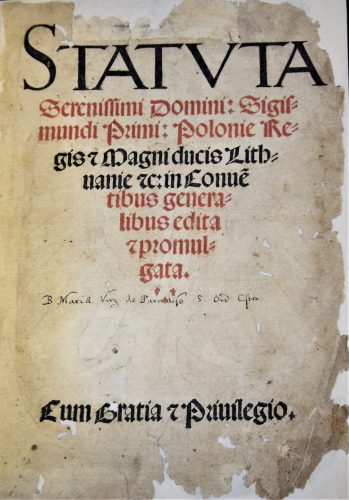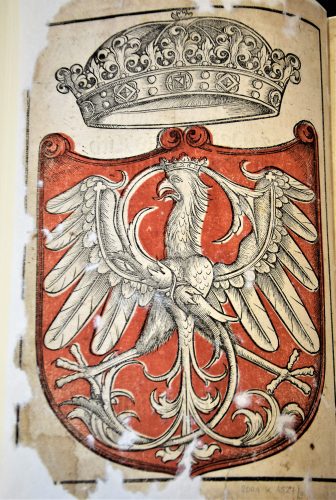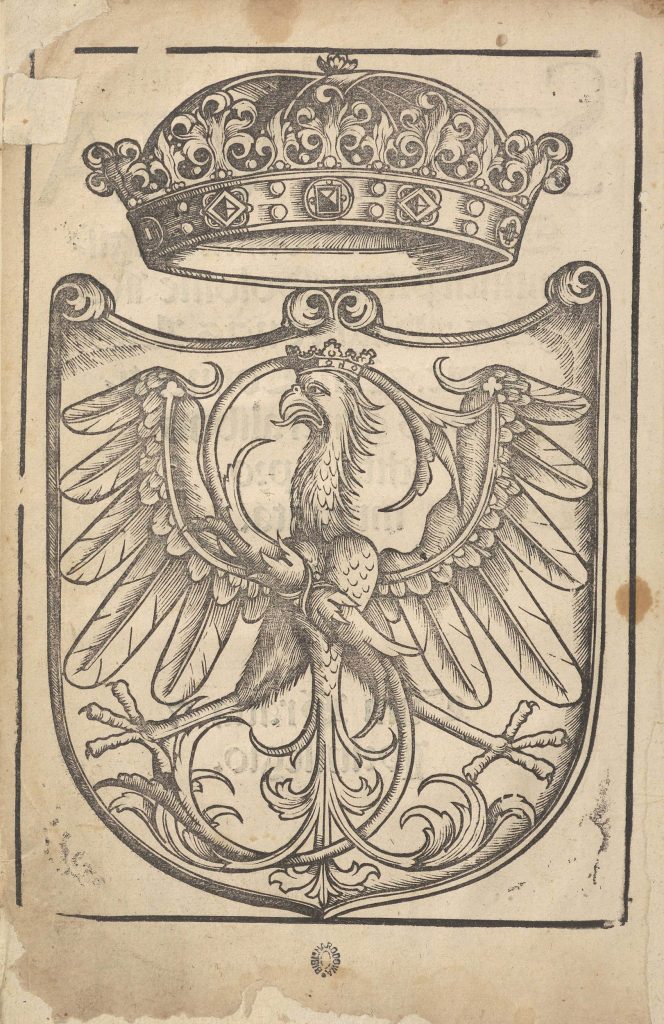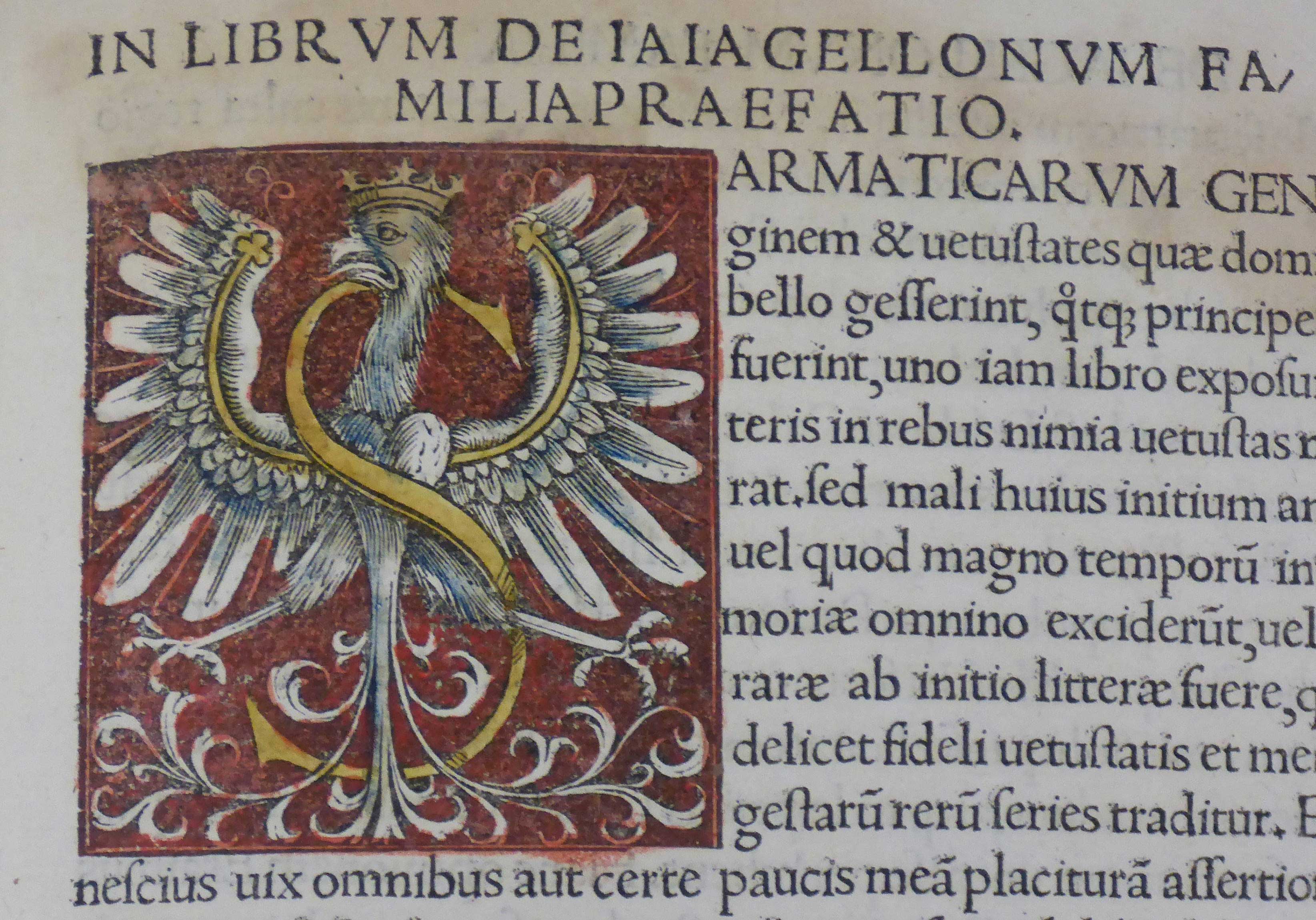If an image was printed in colour, it was generally printed in red. If it was printed in sixteenth-century Poland, it was most commonly the Polish coat of arms, namely the White Eagle with a crown, in a red shield. Typically the heraldic eagle in the red shield appeared in the title pages of official documents, mainly constitutions promulgated by the Polish Parliament. The earliest known example is the so-called Sigismundian Eagle, that is the heraldic eagle with the monogram of the king Sigismund I (1507–1548), printed from two woodblocks in register in the first three editions of the Statuta serenissimi domini Sigismundi Primi Poloniae Regis (edition A of 1524, edition B printed before the end of 1531 and C before 1538), a collection of constitutions from 1507–1523, released by Hieronymus Vietor (and after his death by his wife Barbara) at least eleven times between 1524 and around 1550 (Piekarski, 1929).
Red was at the top of the hierarchy of heraldic colours. As pertinent to popes, emperors and kings, it was the most frequently used colour in medieval coats of arms (Pastoureau 2017: 74). Its practical value, the fact of its easy discernibility to the human eye, further justifies the popularity of red in heraldry. It was the visibility of red that caused its frequent use in the identification devices on the battlefield, from which the coat of arms originates. Likewise, the heraldic symbolism of red referred to bravery and gallantry (Kuczyński 1978: 93). Perhaps it was in these meanings that red appeared on the battle standards of the Polish dukes from the Piast dynasty. As heraldic colours were absolute and conceptual, their shades did not matter (Pastoureau 2017: 74). This eased the work of the printers, who used the same red ink to print texts and coats of arms, as was the case of Hieronymus Vietor.

The A, B and C editions of Statuta had six lines of the title and three small crosses on the title page printed in red (fig.1). The same ink was used to impress the red shield on the verso of the title page (fig.2).

Even though the colour woodcut came out of the press of a renowned printing house, its technical awkwardness demonstrates the main difficulties which even an experienced printer had to face when impressing a colour coat of arms. The first challenge was to register the two blocks in relation to one another. This was not fully successful in Statuta as the red colour goes over the parts of the image which should remain white and obscures the black contour (fig.2). The second problem was the consistency of the red ink. In several studied impressions the ink seeped through the title paper and left a stain on the eagle head. Sometimes the red dots of ink used on the verso of the page are clearly visible on the title page and build up a contour of the Eagle’s wings (as for instance in the copy of Statuta held in the collection of the Princes’ Czartoryski Library/National Museum in Cracow, shelf-mark 29 III Cim). The penetration of the ink through the page suggests that the ink recipe needed improvement. Perhaps these technical complications discouraged Vietor from printing colour in the subsequent editions. Certainly, it was not the deterioration of the woodblock used to impress colour, as it was still in decent shape in the C edition. The line blocks were generally impressed in Vietor’s Statuta as long as possible, regardless of their poor physical shape (cf. fig.3). Even though the colour might have drawn attention away from the faults of the woodblock, it was not considered to be an easy option.
The Sigismundian Eagle with the closed crown (Latin corona clausa) above its head, printed by Vietor, is a combination of the state coats of arms with the monogram of the current king and the symbol of the sovereignty of his power. The closed crown was a characteristic imperial regalia and was used in the iconography of the last Jagiellon rulers in Poland to manifest the idea of the king being an emperor in his own kingdom (according to the Latin phrase rex imperator in regno suo). This mixture of state, royal and personal symbols was unusual in European heraldry. As Mieczysław Morka claims, it was more common to link the ruler’s initials with another emblem in the cases when one intended to stress a feudal dependency between the ruler and a particular territory (Morka 2006: 323). Morka suggests that the close interplay between the state emblem and the king’s name could have been a part of royal propaganda, a manifestation of the unity between the ruler and his kingdom.

Interestingly, the earliest depictions of the Sigismundian Eagle are preserved in Cracow prints. They were impressed on the title pages (fig.4) or as a figural initial (fig.5) from 1518 onwards (Morka 2006: 323-324). If red colour was applied to these images, in each case it was done manually. Vietor was the first to print the Sigismundian Eagle in colour. By placing it at the beginning of the collection of constitutions of the Polish Kingdom he also introduced this emblem into the system of official state symbols. Yet, as far as we know, nobody after Vietor printed the Sigismundian Eagle in red. The subsequent experiments with impressing the Polish coat of arms in colour were undertaken only by Vietor’s successor, Łazarz Andrysowic, in the 1560s. Łazarz learnt his profession as an apprentice in the printing office, which after Vietor’s death was directed by Barbara Vietor. He married the widow, took possession of Vietor’s office and continued its legacy, also in heraldic colour printing. Nevertheless Łazarz was more successful in introducing printing in register to the production of heraldic woodcuts, as the elaborate coat of arms of the Polish kingdom, impressed on the title page of Statuta Regni Poloniae by Jan Herburt (around 1564) in his printing house, was reprinted several times until 1641.


Jaworska, Aleksandra, 2003. Orzeł Biały. Herb państwa polskiego [The White Eagle. The coat of arms of the Polish state]. Warszawa: Wydawnictwo DiG.
Kuczyński, Stefan Krzysztof, 1978. “Barwy biało-czerwone” [White-and-red state colours]. In: Stanisław Russocki, Stefan K. Kuczyński, Juliusz Willaume, Godło, barwy i hymn Rzeczypospolitej. Zarys dziejów [Coat of arms, colours and anthem of the Republic of Poland: Brief history], pp. 83-256. Warszawa: Wiedza Powszechna.
Pastoureau, Michel, 2017. Red: The History of a Color, translated by Jody Gladding. Princeton, New Jersey: Princeton University Press.
Piech, Zenon, 2003. Monety, pieczęcie i herby w systemie symboli władzy Jagiellonów [Coins, seals and coats of arms in the system of Jagiellonian symbols of power]. Warszawa: Wydawnictwo DiG.
Piekarski, Kazimierz, 1939. „Uwagi o chronologii wydań statutów sejmowych z czasów Zygmunta Starego“ [Notes on the chronology of editions of parliamentary statutes from the times of Sigismund the Old]. Przegląd Biblioteczny 3: pp. 478-495.
Morka, Mieczysław, 2006. Sztuka dworu Zygmunta I Starego. Treści polityczne i propagandowe [The art of the Court of Sigismund I the Old. Political and propagandistic content]. Warszawa: Argraf.
[/expand]